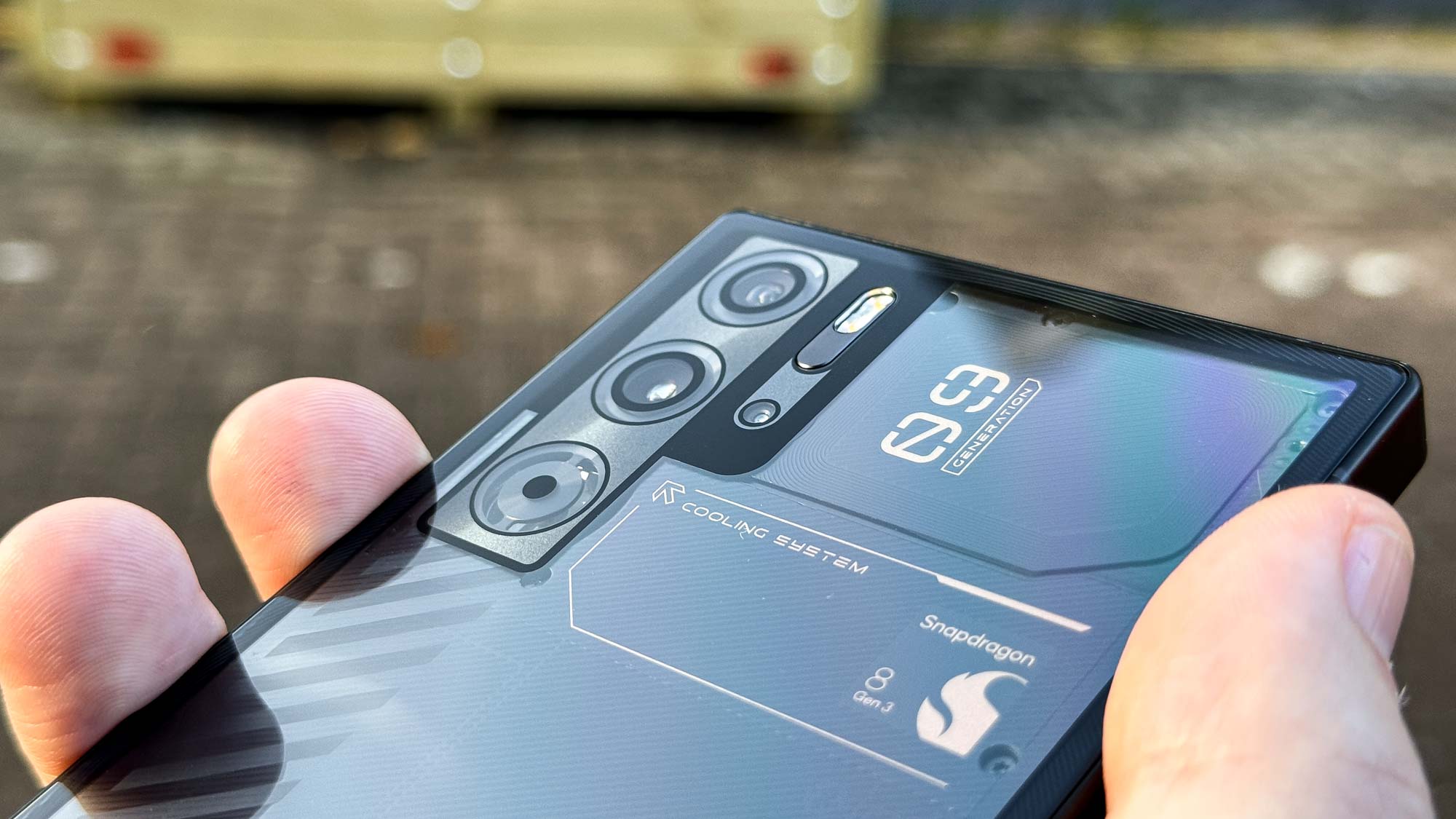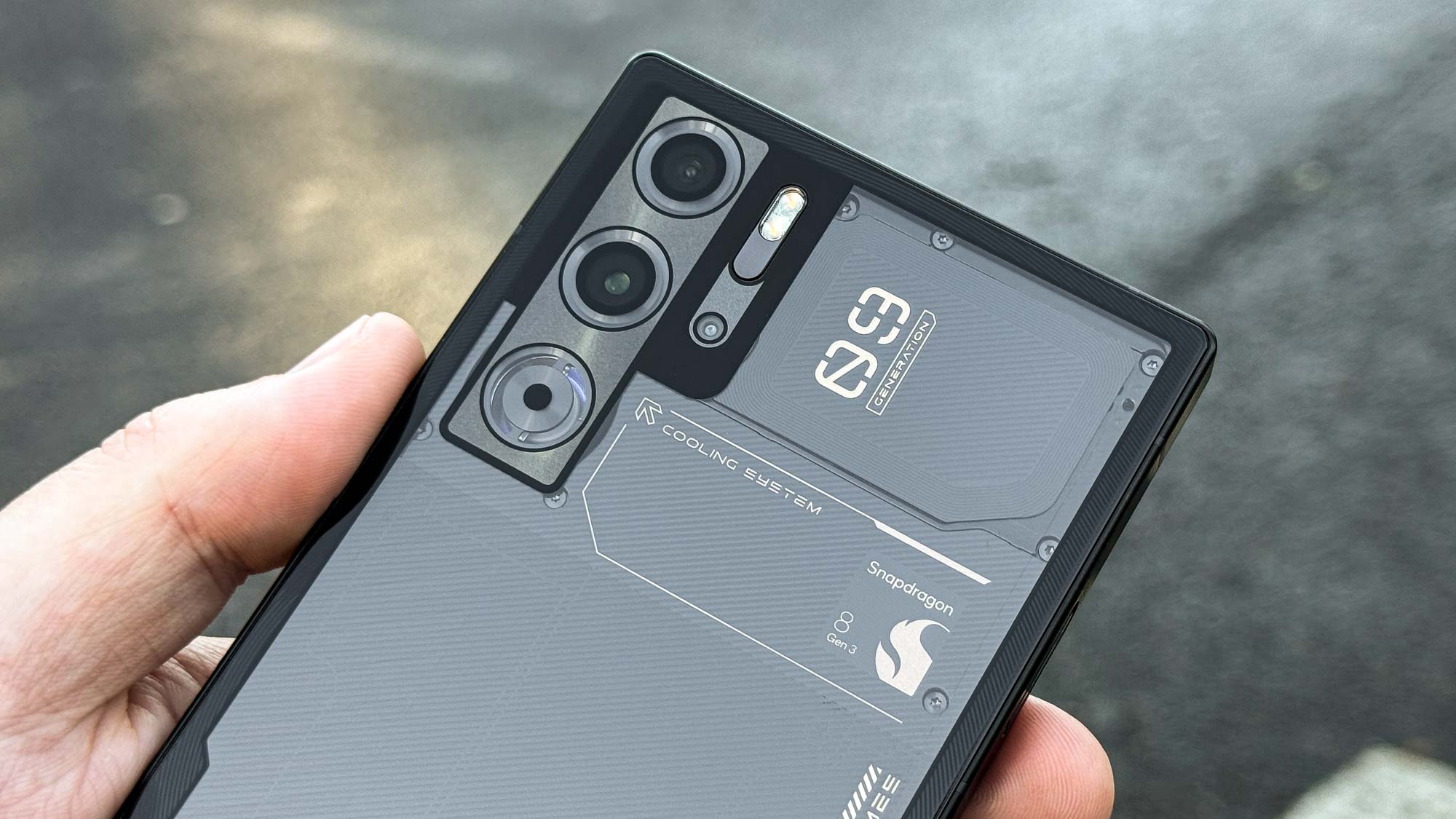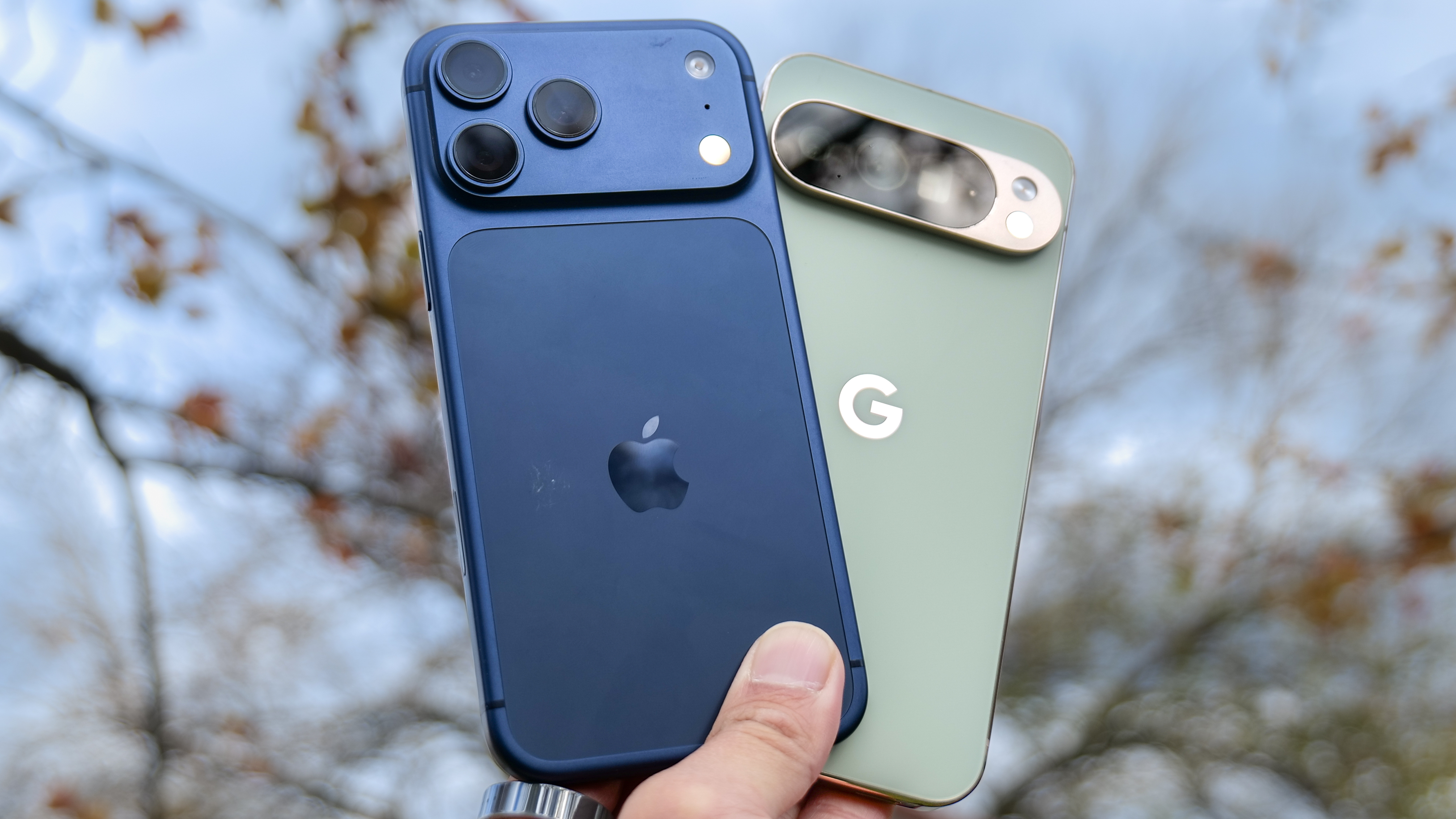Tom's Guide Verdict
RedMagic's new phone marks a big step forward for gaming power with its new chip, increased battery capacity and faster charging. Plus the 9 Pro still has all the gaming features we loved from older RedMagic phones, like side triggers, a cooling fan, a versatile software suite and a surprisingly low price. But like those older phones, the RedMagic 9 Pro's cameras and bad translation job make it harder to recommend.
Pros
- +
Powerful new Snapdragon chip
- +
Bigger battery and faster charging
- +
Bursting with gaming features
Cons
- -
Improved cameras still not good enough
- -
Software is still badly translated
Why you can trust Tom's Guide
Capping off 2023 and starting 2024 with an RGB-lit bang, the RedMagic 9 Pro has arrived to offer an unmatched gaming experience. And while it won't remain unmatched for long, there are still some things it does very well compared to its rivals, even as they get updated.
There have been a few noticeable changes to the beyond the expected part upgrades you see between yearly phone installments. The battery’s gotten larger, and the charger's become faster accordingly. Plus the design's more mature, at least if you turn the glowing lights off.
But some things haven’t changed. The price is still low, its chipset is more powerful than ever, and there’s still a cooling fan, capacitive triggers and lots of in-game tools to try; ideal for the gamer who finds half the fun in gaming is making adjustments in the options menu.
With some strong competitors expected to arrive early next year, the RedMagic 9 Pro may fade into the background. But as this review will show you, it’s got a firm claim to be one of the best gaming phones around, especially if you want the best performance for the least money possible.
RedMagic 9 Pro Review: Specs
| Starting price | $649 / £579 |
| Display | 6.8-inch FHD+ (2,480 x 1,116) |
| Refresh rate | 120Hz |
| Rear cameras | 50MP main, 50MP ultrawide |
| Front camera | 16MP, under-display |
| Chipset | Snapdragon 8 Gen 3 |
| RAM | 12GB, 16GB |
| Storage | 256GB, 512GB |
| Battery | 6,500mAh |
| Charging | 80W wired |
| Software | Android 14 with RedMagic OS 9.0 |
| Dust/water resistance | None |
| Size | 6.46 x 3.0 x 0.35 inches / 163.98 x 76.35 x 8.9 mm |
| Weight | 8.07 ounces / 229 grams |
| Colors | Black, Silver, Transparent/Grey |
RedMagic 9 Pro Review: Price and release date
You can pre-order the RedMagic 9 Pro from December 27, with open sale coming on January 3, 2024, all from RedMagic's own online store. RedMagic is asking for $649 / £579 for the standard 12GB RAM and 256GB storage model, or $799 / £709 for the best 16GB/512GB edition.
At its standard price, the RedMagic 9 Pro is cheaper than the Google Pixel 8 or OnePlus 11 while costing a bit more than the Galaxy S23 FE. For the top-flight model, the most obvious rivals are the Galaxy S23 or iPhone 15, which cost the same in the U.S. but are more expensive than the RedMagic in the U.K.
RedMagic 9 Pro Review: Design
RedMagic's design philosophy for its past few phones has been to make things look edgy and industrial while still making something smart enough to use when you're not actually gaming. The 9 Pro's angular, flat-sided design looks like it means business, but isn't as shouty as prior phones about the potential it holds inside.
Get instant access to breaking news, the hottest reviews, great deals and helpful tips.

That said, it's still a bit unusual looking. For one, it's still got a headphone jack on its top edge, a rarity these days but a welcome feature for users without wireless earbuds. The aluminum sides also house the usual power and volume controls, plus the red Game Space slider for accessing the phone's gaming tools.

The back of the RedMagic is completely flat aside from the flash module, meaning that while it's a little thicker than a normal phone at over a third of an inch, it's very stable when laid flat and doesn't snag when trying to pull it out of a pocket. Hidden below the flush two rear cameras is the cooling fan, almost disguising itself as a third camera sensor, but failing due to its RGB lighting, as well as the air vents on either side of the phone.

You have three color choices total, but these are tied to memory variants of the phone. For instance, Sleet (plain black) is the only available color for the standard 12GB RAM/256GB storage version of the phone. Then there's the 16GB RAM/512GB edition which is offered in Snowfall (silver) or Cyclone, a mostly transparent design that you can see on my review unit. The clear back glass shows a carbon fiber-esque substrate containing RedMagic branding and an extra Snapdragon 8 Gen 3 logo, reminding you what's powering the phone.
RedMagic 9 Pro Review: Display
There's a large 6.8 inch, FHD+ OLED display on the front of the RedMagic 9 Pro, featuring a 120Hz refresh rate plus a 1,600 nits peak brightness according to RedMagic's lab results. It's also got a near-invisible under-display camera in the top center, meaning most of the time you won't have anything getting in the way of your video-viewing or game-watching experience. There's also a snappy 960Hz touch sampling rate, which should help on-screen game controls feel more responsive.

Compared to the Galaxy S23 Ultra, the RedMagic 9 Pro is quite noticeably dimmer even at max brightness. Colors don't pop quite as much on the RedMagic display either, although viewing angles are equally good on both, handy for when you're watching things or sharing photos with others.
For durability, the RedMagic 9 pro's screen boasts a Gorilla Glass 5 display panel - not the most recent Victus 2, but still something to help shrug off damage. Unfortunately, because of the holes in the body required for the cooling fan, there's no water or dust resistance rating for this phone. You'll want to be extra careful to not drop this one in anything that could flow into its internals.
RedMagic 9 Pro Review: Cameras
There are fewer cameras on the RedMagic 9 Pro than on its predecessors. Its total camera count is just three, consisting of 50MP main and 50MP ultrawide cameras on the back, plus a 16MP selfie camera hidden under the display on the front. There's no macro camera unlike previous RedMagic phones, but that is no great loss since these cameras tend to be added more for the benefit of the specs list than close-up photography.

I compared all these cameras to the equivalents on the Google Pixel 8 Pro and found that while the Pixel is clearly deserving of its spot on our best camera phones guide, the RedMagic can produce passable images, at least from its back cameras.
Take this main camera shot along a street in London's Archway neighborhood. The color of the sky in the RedMagic shot isn't too far off of the quality of the Pixel's, but the darker areas such as the tarmac, the building on the left and the trees lining the sidewalk don't pop nearly as much. That not only makes the RedMagic's coloration worse, but it downplays the detail of the shot, which is, in theory, close to that of the Pixel, since they're using near-identical image resolutions.
A little further down the road, I tried out the ultrawide cameras of the RedMagic and the Pixel to fit in an upward-looking view of St. John's Church. I sort of like the increased contrast of the RedMagic photo, since it looks rather dramatic and imposing — as a near-200-year-old church should. But the better color balance of the Google shot helps show off the building at its best.
Finally, we come to the selfie test. Because the RedMagic 9 Pro uses an under-display camera, it was always going to have a quality disadvantage from having to shoot through a layer of pixels. And while the camera has improved from generation to generation, it's still far worse than a standard punch-hole camera.
I don't think this is a particularly good photo of me from the Pixel 8 Pro, but it's still better than the RedMagic's flat, overbright image. While it's fun to see my ear glowing like it's an anime protagonist unlocking a new power level, that's not something I'd upload to my Instagram story willingly. Also despite turning on the portrait mode for both shots, I can see no background blurring effect in the RedMagic image whatsoever.
I admit I never expected the RedMagic 9 Pro to beat the Pixel 8 Pro. However, with the RedMagic costing similar to the Pixel 8 series, it's a good demonstration of what you could be getting instead of a phone focused on its gaming credentials.
RedMagic 9 Pro Review: Performance
The beating heart of the RedMagic 9 Pro is the Snapdragon 8 Gen 3, with RedMagic being one of the first companies to bring a phone to market with this latest generation chipset. Joining it is either 12GB or 16GB of LPDDR5X RAM, and either 256GB or 512GB of UFS 4.0 storage, depending on which version you buy. On top of this, there's RedMagic's own Red Core 2 Pro gaming chip providing support for the phone's unique gaming features (more on those later) so the Snapdragon can focus all its power on your games.
We haven't got the RedMagic into the TG testing lab yet to run benchmarking tests and see just how good the new chip is. But needless to say, we've got high hopes. Fortunately, I did spend a lot of time putting the phone through its gaming paces.

When testing the RedMagic 9 Pro in games such as Asphalt 9: Legends and Grid: Autosport, I found it mostly offered similar gaming performance to the Galaxy S23 Ultra, which uses the older Snapdragon 8 Gen 2 for Galaxy. However in Genshin Impact with the settings at max, there were a couple of framerate hiccups when I was in combat on the S23 Ultra that I didn't see while fighting baddies on the RedMagic.
I was hoping for a bigger difference since the RedMagic 9 Pro is running on newer silicon. But perhaps because the 8 Gen 2 chip's more optimized, or games like Genshin Impact haven't got performance settings to take advantage of the newest chips, we won't see the new chip, and therefore the RedMagic, come into its own for a little while yet.
RedMagic 9 Pro Review: Battery and charging
Inside the RedMagic 9 Pro is a 6,500 mAh battery, a nice increase from the already large 6,000 mAh battery in the RedMagic 8 series and 8S series models. We've not been able to test the RedMagic battery life in our lab yet, but from my time using the phone day-to-day, I'm confident that it's going to score highly just like previous RedMagic phones have done, and gain a spot on our best phone battery life leaderboard.
The RedMagic 9 Pro's charging speed was something I could test myself though. With its included 80W wired charger, I got the phone from 0% to 44% charged after 15 minutes plugged in, to 81% in 30 minutes and 100% in 42 minutes. That's only a little slower than the older RedMagic phones, and still far faster than the 45W charging of the Galaxy S23 Ultra (which manages 57% in 30 minutes) or the 30W charging of the Pixel 8 Pro (59% in 30 minutes).
RedMagic 9 Pro Review: Software and special features
You'll find Android 14, in the form of RedMagic OS 9.0, running things on the RedMagic 9 Pro. The quality of this flavor of Android is marred by poor translation, something RedMagic and its parent company ZTE somehow still can't get right after years of selling phones outside of China. However, everything you need is still here, even if it's worded in a way that makes it hard to recognize.
But you won't be buying this phone for its standard features — you're here for the gaming stuff, which you primarily access by sliding the big red switch on the right side to open up the Game Space. This is a dedicated launcher from which you can start your games easily as well as set up all the other gaming goodies this phone offers, as well as install plug-ins to enhance your gaming experience in exactly the way you want.

One of the biggest of these is the returning capacitive shoulder triggers, which now boast new and more customizable RGB lighting, improved sweat resistance (lovely) and enhanced sensitivity. Once you turn these on, they'll "tap" whichever area of the screen you set them to, improving basically any game as it makes the controls more like a gamepad. While it takes a bit of work to set them up, which you'll have to do for every game you use them in, they are definitely an effective way of controlling commonly-used functions, like accelerator/brake in a racing game, or aim-down-sights/fire in a shooter.
If you want to play on a larger screen, the RedMagic's USB-C comes with HDMI support for up to the same 120Hz refresh rate as the built-in display. Add a Bluetooth controller and headset, and you've got yourself a rather portable games console, especially if you install game streaming apps like Xbox Game Pass or PlayStation Remote Play.

Lastly, there's the signature RedMagic cooling fan, capable of reducing the whole phone's heat by 18 degrees Celsius according to the company's own testing. Sure enough, the phone's body never gets uncomfortably hot to hold, and in-game performance remains steady over long periods.
RedMagic 9 Pro Review: Verdict
By launching with brand-new hardware earlier than its competition, the RedMagic 9 Pro arguably deserves to be among the best phones, best Android phones and best gaming phones. But since this lead's likely to be short-lived with the Galaxy S24 series, OnePlus 12, and Asus ROG Phone 8 expected in early 2024, let's look at the RedMagic's upsides that'll stay upsides.
It's a very competitively priced device for one — it's going to be hard to get more performance for less money, both in terms of CPU and GPU might, charging speed and battery life longevity. And the sheer volume of gaming-focused features like the trigger buttons, cooling fan and Game Space plug-ins should provide at least some help to every kind of mobile game. Let's just hope your friends don't consider it cheating.
Photography is still a RedMagic weakness, although at least it's quite a bit better than last year's efforts from the company. And I'll keep criticizing the OS' translation from Chinese no matter how many times RedMagic makes the same mistake. Maybe these are worthwhile things to give up for you, hardcore gamer that you are. But unless you're truly taken aback by the price and the in-game special features of the RedMagic 9 Pro, you may still want to consider a Galaxy or a Pixel as a better-rounded choice.

Richard is based in London, covering news, reviews and how-tos for phones, tablets, gaming, and whatever else people need advice on. Following on from his MA in Magazine Journalism at the University of Sheffield, he's also written for WIRED U.K., The Register and Creative Bloq. When not at work, he's likely thinking about how to brew the perfect cup of specialty coffee.
